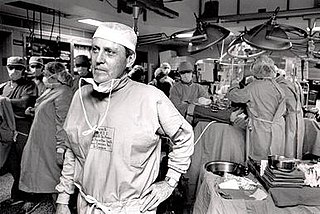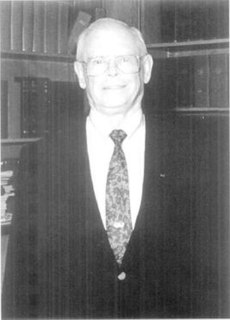Related Research Articles

Stanford University School of Medicine is the medical school of Stanford University and is located in Stanford, California. It traces its roots to the Medical Department of the University of the Pacific, founded in San Francisco in 1858. This medical institution, then called Cooper Medical College, was acquired by Stanford in 1908. The medical school moved to the Stanford campus near Palo Alto, California, in 1959.

Baylor College of Medicine (BCM) is a private stand-alone health sciences university located in Houston, Texas within the Texas Medical Center, the world's largest medical center. BCM is composed of four academic components: the School of Medicine, the Graduate School of Biomedical Sciences; the School of Health Professions, and the National School of Tropical Medicine. The school is part owner, alongside Catholic Health Initiatives (CHI), of Baylor St. Luke's Medical Center, the flagship hospital of the CHI St. Luke's Health system. Other affiliated teaching hospitals and research institutes include Harris Health System's Ben Taub Hospital, Texas Children's Hospital, The University of Texas MD Anderson Cancer Center, TIRR Memorial Hermann, the Menninger Clinic, the Michael E. DeBakey VA Medical Center, and the Children's Hospital of San Antonio.
The University of Texas Southwestern Medical Center is a public academic health science center in Dallas, Texas. With approximately 13,568 employees and 2,445 faculty and over 2.7 million outpatient visits per year, UT Southwestern is the largest medical school in the University of Texas System and state of Texas.

The Warren Alpert Medical School is the medical school of Brown University, located in Providence, Rhode Island, United States. Established in 1811, the school was among the first in the nation to offer academic medical education. Today, Alpert Medical School is a component of Brown’s Division of Biology and Medicine, which also includes the Program in Biology. Together with the Medical School’s seven affiliated teaching hospitals, the Division attracts over $300 million in external research funding per year.
Capital Medical University, also known as CMU, is a university in Beijing, China, which was originally called Beijing Second Medical College (北京第二醫學院).

Edward Donnall "Don" Thomas was an American physician, professor emeritus at the University of Washington, and director emeritus of the clinical research division at the Fred Hutchinson Cancer Research Center. In 1990 he shared the Nobel Prize in Physiology or Medicine with Joseph E. Murray for the development of cell and organ transplantation. Thomas and his wife and research partner Dottie Thomas developed bone marrow transplantation as a treatment for leukemia.
The University of North Texas Health Science Center (UNTHSC) is a public medical school in Fort Worth, Texas. It is a graduate-level institution of the University of North Texas System. Established in 1970, UNT Health Science Center consists of five colleges with a total enrollment of 2,243 graduate students (2014–15). The institution offers degrees in both osteopathic and allopathic medicine, public health, pharmacy, physical therapy, physician assistant studies, and biomedical sciences.

Thomas Earl Starzl was an American physician, researcher, and expert on organ transplants. He performed the first human liver transplants, and has often been referred to as "the father of modern transplantation." A documentary, entitled "Burden of Genius," covering the medical and scientific advances spearheaded by Starzl himself, was released to the public in 2017 in a series of screenings.
Edward ("Ted") Hance Shortliffe is a Canadian-born American biomedical informatician, physician, and computer scientist. Shortliffe is a pioneer in the use of artificial intelligence in medicine. He was the principal developer of the clinical expert system MYCIN, one of the first rule-based artificial intelligence expert systems, which obtained clinical data interactively from a physician user and was used to diagnose and recommend treatment for severe infections. While never used in practice, its performance was shown to be comparable to and sometimes more accurate than that of Stanford infectious disease faculty. This spurred the development of a wide range of activity in the development of rule-based expert systems, knowledge representation, belief nets and other areas, and its design greatly influenced the subsequent development of computing in medicine.
Bruce C. Kone is an American professor, nephrologist and molecular biologist. He is also a United States Masters Swimming (USMS) national record holder, twenty-three-time USMS national champion, and eight-time FINA Masters world's top-ranked age group swimmer. He is currently a tenured professor of medicine at the University of Texas Health Science Center at Houston (UTHealth).

Vanderbilt University School of Medicine is a graduate medical school of Vanderbilt University located in Nashville, Tennessee. Located in the Vanderbilt University Medical Center on the southeastern side of the Vanderbilt University campus, the School of Medicine claims several Nobel laureates in the field of medicine. Through the Vanderbilt Health Affiliated Network, VUSM is affiliated with over 60 hospitals and 5,000 clinicians across Tennessee and five neighboring states, managing more than 2 million patient visits each year. It is considered one of the largest academic medical centers in the United States and is the primary resource for specialty and primary care in hundreds of adult and pediatric specialties for patients throughout the Mid-South.
Case Western Reserve School of Medicine is one of the graduate schools of Case Western Reserve University, and is located in the University Circle neighborhood of Cleveland, Ohio. The School of Medicine is among the top 25 medical schools in the United States and is the top-ranked medical school of Ohio in research per U.S. News & World Report. Additionally, Case School of Medicine is the largest biomedical research center in Ohio. In 2015, the average MCAT score for the entering class was 36.

Alvin P. Shapiro was an American physician and professor primarily at the University of Pittsburgh School of Medicine. Shapiro was the recipient of a Lasker Award and was known for his research in hypertension, behavioral sciences, and related diseases.
Joe G. N. "Skip" Garcia is an American pulmonary scientist, physician and academician.

Jay Philip Sanford was a noted American military physician and infectious disease specialist. He held a chair in Tropical Medicine and was author of The Sanford Guide to Antimicrobial Therapy. From 1975 until 1990, he was dean, then president, of the Uniformed Services University of the Health Sciences in Bethesda, Maryland. He received numerous lifetime honors, awards, and accolades.
Paul Whelton is an Irish-born American physician and scientist who has made seminal contributions to hypertension and kidney disease epidemiology. He also mentored numerous public health leaders including the deans of the schools of public health at Johns Hopkins and Columbia. He currently serves as the Show Chwan Health Care System Endowed Chair in Global Public Health and a Clinical Professor in the Department of Epidemiology at the Tulane University School of Public Health and Tropical Medicine. He is the founding director of the Welch Center for Prevention, Epidemiology, and Clinical Research at Johns Hopkins University.
Helen Hobbs, M.D., is a professor at the University of Texas Southwestern Medical Center, and a Howard Hughes Medical Institute Investigator, who won a 2016 Breakthrough Prize in Life Sciences and the 2018 Harrington Prize for Innovation in Medicine. She and Jonathan C. Cohen found that people with hypomorphic PCSK9 mutations had lower LDL-cholesterol levels and were almost immune to heart disease. This finding led to the development of a new class of cholesterol-lowering drugs that mimic the effects of the PCSK9 mutations. She and Jonathan Cohen also identified the first genetic risk factor for fatty liver disease, a burgeoning health problem that can lead to cirrhosis and liver cancer. Their laboratory has shown that mutation in PNPLA3 causes accumulation of PNPLA3 on lipid droplets, which compromises the mobilization of triglycerides from liver cells. She sits on the Board of Directors at Pfizer.
Dimitrios P. Kontoyiannis is the Texas 4000 Distinguished Professor and Deputy Head of Research in the Division of Internal Medicine at The University of Texas MD Anderson Cancer Center in Houston, Texas. He received his medical degree Summa Cum Laude from the National and Kapodistrian University of Athens, Greece. Kontoyiannis was trained in Internal Medicine at Baylor College of Medicine in Houston, TX, where he served as a Chief Medical Resident. He was subsequently trained as a clinical fellow in Infectious Diseases at Massachusetts General Hospital and obtained a Masters in Clinical Sciences from Harvard Medical School in Boston. He spent three years at the Whitehead Institute for Biomedical Sciences/Massachusetts Institute of Technology as a fellow in the Harvard MIT Clinical Investigators Training Program.
C. Venkata S. Ram is a globally recognized expert in the treatment of high blood pressure (hypertension). He has dedicated his entire life for the early diagnosis and proper treatment of hypertension. Presently, he is serving as the director of blood pressure clinics and institute for blood pressure management at Apollo Hospitals, and Apollo Medical College, Hyderabad, India. He is also the director of World Hypertension League South Asia region and Dean, Macquarie University, Medical School, India campus, Hyderabad, India. Plus he is a professor of medicine/clinical at the University of Texas Southwestern Medical School, Dallas, USA. At all these institutions, he continues to work as a consultant physician, teacher, and a researcher. To date, he has authored 360 papers and 4 books--- all in hypertension.
Daniel Kalman Podolsky is an American gastroenterologist and member of the National Academy of Medicine. He serves as President of the University of Texas Southwestern Medical Center. and co-Chairman of Southwestern Health Resources, a collaboration between UT Southwestern and Texas Health Resources that cares for patients across North Texas and includes more than 30 hospitals, 300 clinics, and 2,600 physicians.
References
- 1 2 3 "Willis Maddrey". utsouthwestern.edu. Retrieved July 25, 2020.
- ↑ "About Willis C. Maddrey, MD". Southern Society for Clinical Investigation. Retrieved 25 July 2020.
- ↑ "Maddrey, Willis". worldcat.org. Retrieved January 27, 2017.
| This biographical article related to medicine in the United States is a stub. You can help Wikipedia by expanding it. |